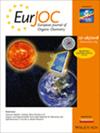Regio‐ and stereoselective alkyl enol ether synthesis via microwave‐promoted, base‐catalysed alkyne hydroalkoxylation
IF 2.5
3区 化学
Q2 CHEMISTRY, ORGANIC
引用次数: 0
Abstract
The diverse reactivity presented by alkyl enol ethers underpins a wide range of synthetically significant processes. Their synthesis is often achieved by atom‐economical alkyne hydroalkoxylation (i.e., addition of an alcohol across an alkyne), either using superbasic conditions or transition metal catalysis. Unfortunately, the harsh conditions of the former approach limit substrate tolerance whilst the latter approach often requires inert, anhydrous conditions and exotic, expensive catalysts. In order to pursue more convenient, general and sustainable methodology for enol ether synthesis, we have developed microwave‐promoted alkyne hydroalkoxylation as an attractive solution. Our optimised conditions employ caesium carbonate as a mild base catalyst and the required alcohol as solvent and reagent, with reaction temperatures from 20‐150 °C and reaction times from 10‐60 minutes. We have demonstrated that the reaction shows broad tolerance of diverse substrate functionality (e.g., ester, ether, carboxylate, nitrile, nitro, halide), including examples of terminal, internal, aryl and alkyl alkynes. Greatest reactivity is observed with electron‐poor alkyne substrates, and the reaction shows near‐complete anti‐Markovnikov regioselectivity and a very strong stereochemical bias towards Z‐configured enol ether products. These observations are consistent with a polar mechanism proceeding via a vinyl anion intermediate, and we provide empirical and computation evidence in support of this.求助全文
约1分钟内获得全文
求助全文
来源期刊
CiteScore
5.40
自引率
3.60%
发文量
752
审稿时长
1 months
期刊介绍:
The European Journal of Organic Chemistry (2019 ISI Impact Factor 2.889) publishes Full Papers, Communications, and Minireviews from the entire spectrum of synthetic organic, bioorganic and physical-organic chemistry. It is published on behalf of Chemistry Europe, an association of 16 European chemical societies.
The following journals have been merged to form two leading journals, the European Journal of Organic Chemistry and the European Journal of Inorganic Chemistry:
Liebigs Annalen
Bulletin des Sociétés Chimiques Belges
Bulletin de la Société Chimique de France
Gazzetta Chimica Italiana
Recueil des Travaux Chimiques des Pays-Bas
Anales de Química
Chimika Chronika
Revista Portuguesa de Química
ACH—Models in Chemistry
Polish Journal of Chemistry.

 求助内容:
求助内容: 应助结果提醒方式:
应助结果提醒方式:


